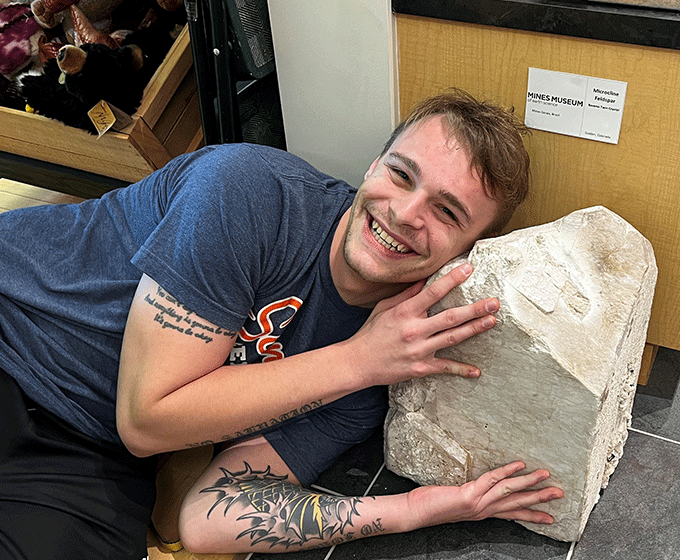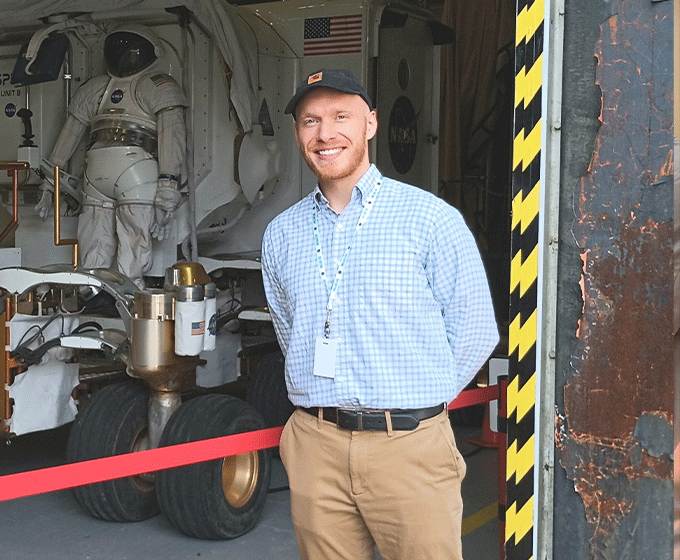
AUGUST 9, 2024 — NASA has awarded Space Technology Graduate Research Opportunity (NSTGRO) fellowships to UTSA students Austin Patridge and Nicholas Stegmeier. The grants will enable the UTSA graduate students to conduct research that advances NASA’s technology in future space exploration.
Patridge and Stegmeier will conduct the research at UTSA and NASA centers over the next few years. Patridge will research materials for use in building lunar landing pads. Stegmeier will research ways to improve atmospheric reentry and landing technology.
Chris Combs, the Dee Howard Memorial Endowed Faculty Fellow in the UTSA Department of Mechanical Engineering, said the NASA grants are indicative of the exceptional students UTSA attracts and nurtures.
"NSTGRO is the most prestigious graduate fellowship provided by NASA,” Combs said. “When you look at the list of awardees, you can tell that these awards are going to top students at big-name schools. It’s great for UTSA to have not one but two students on this list in 2024. It shows how our students are special and can hold their own with the best of the best.”
Other schools with two students include USC, Georgia Tech, Purdue, the University of Colorado Boulder, the University of Chicago, Stanford, and the University of Michigan.
Currently, there is little data available in either Stegmeier’s or Patridge’s field of study. The research that the students conduct will be important as NASA plans trips to the moon and Mars.
“Texas is home to a robust space economy with organizations like Blue Origin, Astroport, Axiom, and NASA, which have facilities based in the state,” Combs said. “San Antonio and UTSA are in the middle of this space economy and are well-positioned to provide research support to the industry.”
 Austin Patridge
Austin PatridgePatridge aims to discover the most resilient materials for lunar landing pad bricks. These building blocks will need to meet the physical and thermal thresholds that come with repeated rocket landings and takeoffs for future exploration missions on the moon.
Patridge will explore the calorimetry of the materials. Calorimetry is the process of measuring the heat released or absorbed during a change of state, such as through a chemical reaction.
“To date, nobody has measured the high-temperature calorimetry of lunar materials enough to completely melt the material,” said Patridge, a geosciences student in the UTSA College Sciences. “The Moon has no atmosphere and has one-sixth of the Earth’s gravity, so projectiles can travel very far and very fast; deadly hazards for astronauts. A solution to plume-surface interactions on the Moon is landing pad bricks. However, there are problems with testing bricks here on Earth as they rely on simulants of variable merit and that have not been verified thermodynamically to Apollo soils.”
Patridge aims to uncover the melting behavior of lunar soils by measuring the high-temperature heat capacity of Apollo soil samples. This data will be instrumental in identifying the most thermodynamically comparable lunar simulant: a material specifically designed to replicate the Moon’s soil. By bridging this knowledge gap, Patridge will pave the way for developing robust and effective lunar construction bricks and materials, essential for further Moon missions.
Patridge’s grant is for two years, with an option for a third year. He will be working closely with his PI and master’s advisor Alan Whittington, a professor in the UTSA Department of Earth and Planetary Sciences.
Once Patridge finds a simulant that is thermodynamically similar to lunar soils, he plans to manufacture simulant bricks through various melting and sintering methods and then test them at the NASA Marshall Space Flight Center’s plasma torch testing facility to evaluate which are strongest for future brick production.
 Nick Stegmeier
Nick StegmeierMeanwhile, Stegmeier will study entry, descent and landing technologies for vehicles that could travel to the moon and to Mars. Existing technology is only good for small vessels and light payloads.
“Those are much too light and too small for establishing a Mars base,” Stegmeier said. “If we want to land large spacecraft near each other on Mars, you need some sort of precision landing. You need some way to control how you come through the atmosphere.”
Stegmeier says the science is tricky because the physics change from space through the less-dense upper atmosphere of a planet to the lower atmosphere.
Stegmeier’s grant will support his research over the next three years. He will work with Combs, who is his doctoral advisor, and NASA researchers.
“This is an honor that Nick will carry with him for the rest of his career whether he works at NASA or somewhere else in the aerospace enterprise,” Combs says. “He will have a foot in the door at NASA through a technical mentor and annual multiweek on-site experiences at NASA centers while he completes his Ph.D.”
Stegmeier, a Ph.D. candidate in mechanical engineering at the Margie and Bill Klesse College of Engineering and Integrated Design, said he hopes to contribute significantly to the amount of data on this topic.
“With NASA, we’re going back to the moon, and we’re eventually going to Mars. This is the kind of work that will help us get there,” said Combs.
UTSA Today is produced by University Communications and Marketing, the official news source of The University of Texas at San Antonio. Send your feedback to news@utsa.edu. Keep up-to-date on UTSA news by visiting UTSA Today. Connect with UTSA online at Facebook, Twitter, Youtube and Instagram.
Move In To COLFA is strongly recommended for new students in COLFA. It gives you the chance to learn about the Student Success Center, campus resources and meet new friends!
Academic Classroom: Lecture Hall (MH 2.01.10,) McKinney Humanities BldgWe invite you to join us for Birds Up! Downtown, an exciting welcome back event designed to connect students with the different departments at the Downtown Campus. Students will have the opportunity to learn about some of the departments on campus, gain access to different resources, and collect some giveaways!
Bill Miller PlazaCome and celebrate this year's homecoming at the Downtown Campus with food, games, giveaways, music, and more. We look forward to seeing your Roadrunner Spirit!
Bill Miller PlazaThe University of Texas at San Antonio is dedicated to the advancement of knowledge through research and discovery, teaching and learning, community engagement and public service. As an institution of access and excellence, UTSA embraces multicultural traditions and serves as a center for intellectual and creative resources as well as a catalyst for socioeconomic development and the commercialization of intellectual property - for Texas, the nation and the world.
To be a premier public research university, providing access to educational excellence and preparing citizen leaders for the global environment.
We encourage an environment of dialogue and discovery, where integrity, excellence, respect, collaboration and innovation are fostered.